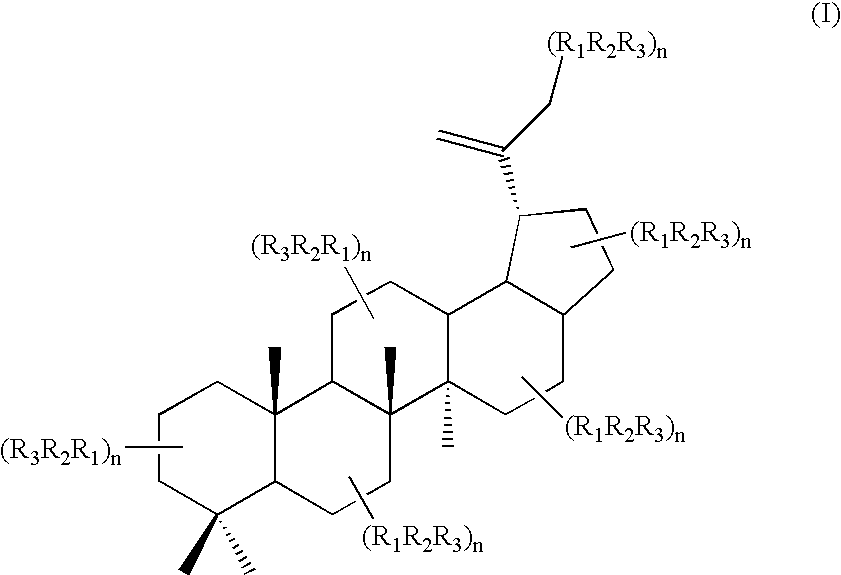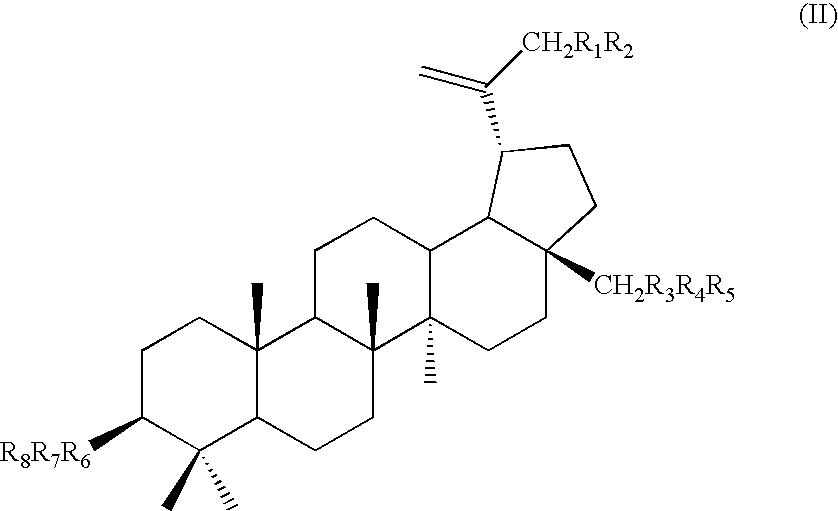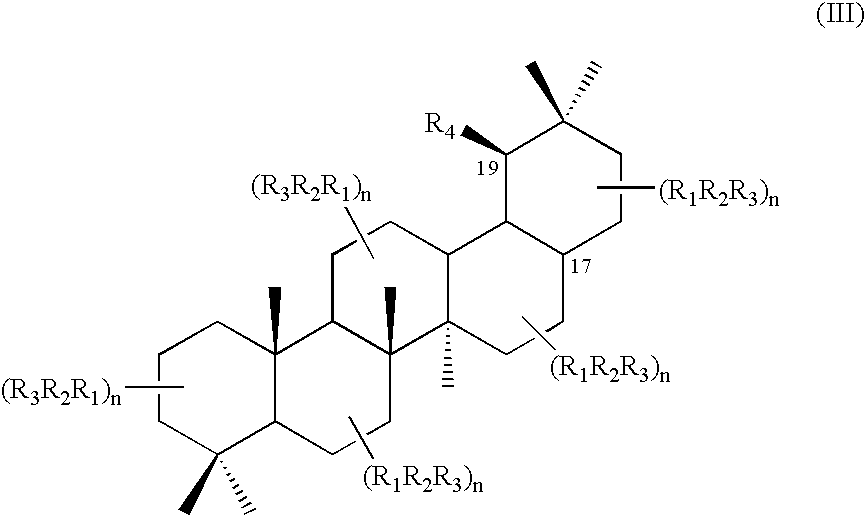Triterpene quaternary salts as biologically active surfactants
a technology of biological activity and surfactants, applied in the field of triterpene quaternary salts as biologically active surfactants, can solve the problems of difficult handling and administration of triterpenoids, the function of plants not fully understood, and the hydrophobic compounds with relatively low interfacial activity and water solubility, etc., to achieve easy handling, reduce the risk of the environment, and have a large amount of starting materials. the effect of relatively inexpensive and high stability
- Summary
- Abstract
- Description
- Claims
- Application Information
AI Technical Summary
Benefits of technology
Problems solved by technology
Method used
Image
Examples
example 1
Lup-20(29)-ene3,28-bis-(N-pyridiniumacetate) dichloride
4.0 g (67.1 mmol) of betulin-3,28-dichloroacetate was dissolved in 20 ml of dry pyridine and the solution kept at 80° C. for 6 h. The mixture was placed then into benzene, the precipitate filtered, washed with the brine, and dried to yield 5.0 g (98.8%) of the product. NMR 1H (DMSO, TMS, 300 MHz): 9.18 (T, 2×2H, Pyr-H), 8.74 (T, 2×1H, Pyr-H) 8.27 (DD, 2×2H, Pyr-H), 5.80 (P, 4H, —CO—CH2), 4.64 (D, 1H, 29-H), 4.53 (DD, 1-H, 3-H), 4.36 (D, 1H, 28-H), 3.91 (D, 1H, 3-H), 1.91 (M, 1H, 19-H), 1.65, 0.97, 0.95, 0.84, 0.79, 0.67 (all S, 6×3H, 30-, 27-, 26-, 25-, 24-, 23-Me), 1.01-1.64 (complex CH—, CH2, 24H); NMR 13C (DMSO): 167.36, 166.58, 150.55, 147.65, 146.84,128.72, 110.88, 84.35, 65.24, 61.23, 55.46, 50.34, 48.98, 47.84, 46.74, 43.02, 41.17, 38.50, 38.25, 37.99, 37.27, 34.63, 29.77, 28.47, 27.34, 25.49, 23.82, 21.15, 19.53, 18.42, 16.88, 16.51, 16.37, 15.22 IR(KBr): 3426, 2944, 2872, 1742, 1631, 1272, 1222.
example 2
Lup-20(29)-ene-3-[N-(4-oxybutyl)-1,4-diazabicyclo[2.2.2]octyl-N′-acetite]
To 3.0 g of betulin-3-chloroacetate (5.85 mmol) in 100 ml of 1-butanol, 1.29 g (5.85 mmol) of N-(4-oxybutyl) DABCO chloride was added and the mixture was refluxed overnight. The solvent was evaporated until a viscous liquid formed. Dry toluene was added and mixed until a solid material appeared. The latter was filtered and dried to yield 4.03 g (93%) of the product. 1H NMR (DMSO, TMS): 3.28-4.53 (complex CH2, 21H), 3.07 (D, 1H, 28-H), 0.83-1.87 (complex CH, CH2, CH3).
example 3
Lup-20(29)-ene-3,28-bis[N-(1,4-diaza[2,2,2]bicycloocyl)acetate]dichloride
To a solution of 8.0 g (13.4 mmol) of betulin-3,28-dichloroacetate in 40 ml of dry dimethylformamide, 6.0 g (4×13.4 mmol) of DABCO (diazabicyclooctane) in 20 ml of DMFA was added at once. In a few minutes, a white precipitate was formed. The mixture was kept at room temperature for 24 hr. The precipitate filtered off, washed with DMPA then with dry benzene, and dried at 90° C. in vacuum. Yield 9.1 g (8.28%) IR (KBr) cm−1.
1H NMR (DMSO, TMS) 4.72 (S, 1H, 29-H), 4.58 (S, 1H, 29-H), 4.47 (S, 2×2H, CH2—CO), 4.42 (DD, 1H, 29-H), 3.92 (DD, 1H, 29-H), 3.51 (T, 12H, DABCO H), 3.08 (T, 12H, DABCO H), 1.93 (M, 1H, 19-H), 1.66, 1.01, 0.97, 0.84, 0.82 (all S, 5×3H, 27-, 26-, 25-, 24-, 23-Me), 1.09-1.45 (complex CH—, CH2, 25H); 13C NMR (DMSO, TMS) 165.06, 164.53, 149.80, 110.22, 82.65, 63.59, 60.66, 54.40, 52.23, 49.42, 48.25, 46.99, 46.17, 44.52, 42.37, 37.64, 37.12, 36.62, 33.61, 29.16, 27.77, 26.68, 24.75, 23.33, 20...
PUM
| Property | Measurement | Unit |
|---|---|---|
| Composition | aaaaa | aaaaa |
| Electrical resistance | aaaaa | aaaaa |
| Fungicidal properties | aaaaa | aaaaa |
Abstract
Description
Claims
Application Information
 Login to View More
Login to View More - R&D
- Intellectual Property
- Life Sciences
- Materials
- Tech Scout
- Unparalleled Data Quality
- Higher Quality Content
- 60% Fewer Hallucinations
Browse by: Latest US Patents, China's latest patents, Technical Efficacy Thesaurus, Application Domain, Technology Topic, Popular Technical Reports.
© 2025 PatSnap. All rights reserved.Legal|Privacy policy|Modern Slavery Act Transparency Statement|Sitemap|About US| Contact US: help@patsnap.com



